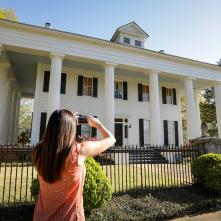CENTRAL STATE HOSPITAL WAS ONCE THE WORLD'S LARGEST MENTAL HEALTH HOSPITAL. IT HOUSED MORE 12,000 PATIENTS IN THE 1960S.
Claire Davis for 13 WMAZ
Central State Hospital is a product of the 19th century's effort to help care for mentally-ill patients. It was once the world's largest mental health hospital. It housed more 12,000 patients in the 1960s. With so many years gone by and so many stories to tell, what history lies behind these walls?
Historian Edwin Atkins is fascinated with Milledgeville and its history. "Milledgeville State Hospital, the State Asylum, the Sanitarium," said Atkins.
"The patients were brought here usually in a car or ambulance, police. They came down this driveway and they were offloaded under the front porch into a secure door and then taken in for processing,"
The building was completed in 1858 and known as The Center Building. Its doors were often a symbol of a patient's road to recovery.
In 1879, it was named for Doctor Theophilus Powell, the hospital's superintendent from 1879 until 1907. Atkins says Powell is considered one of the fathers of mental health reform. "
The building's intricate details and architecture echoed Powell's thinking about how a mental health hospital should look. "They did not want to infer that the family was coming to a prison, or to an insane asylum. That did not have a moral kind of attitude and therapy about it," said Atkins.
On the edge of the pecan grove sits the Jones Building, the heart of Central State Hospital in the 1800s. "Where the operating room, the cafeteria, X-Ray, pathology," said Atkins.
The operating room was one place where Gloria Williams assisted doctors during her 30 years as a nurse. "There were patients everywhere," she said.
Williams came to Central State in January 1960. She had several roles, including teaching nursing students how to care for patients."It was rewarding but it was also challenging," Williams said.
"Very often we would do 75 or 80 shock treatments, or ESTs. Our shock days were Monday, Wednesday, and Fridays," said Williams.
Before shock treatments, doctors at Central State routinely performed lobotomies. Removing part of the patient's brain to alter their behavior. "It was once a desired treatment many years ago for people with severe depression or people who were chronically psychotic or schizophrenic," said Williams.
Contrary to popular belief, she says, most patients were not confined to the wards. "We would have parties out here for the patients, we had watermelon cuttings, we had Easter egg hunts. There was always something going on," said Williams.
Williams retired in 1995 and the hospital has changed, even since then. Central State Hospital closed in 2010, after years of questions about how patients were treated. (*The article incorrectly states that the hospital closed in 2010. While the hospital does serve far fewer people than it once did, it’s open and expanding. A brand new facility was opened in March of 2018.) In Georgia, and across the country, mental health services moved away from large institutions to group home settings. "Just to see this grand old building in such disrepair is just a sad, sad experience," said Williams.
Now some of the buildings are abandoned and unsafe to enter. But one thing is for sure...Central State Hospital still looms over the city of Milledgeville and in the minds of those who walked the halls.
These days the Hospital Redevelopment Authority is working to revitalize the campus. Mike Couch runs the organization and says there are several projects they're working on. One is the youth challenge academy, a program designed to help at-risk teens graduate high school. Another is the Bostick Center, a Geriatric facility for elderly parolees.
Originally Posted: http://www.13wmaz.com/story/news/local/milledgeville/2015/11/02/inside-central-state-hospital-history/74829994/
 Things To Do
Things To Do
 Events
Events
 Food & Drink
Food & Drink
 Hotels & Lodging
Hotels & Lodging
 Plan Your Trip
Plan Your Trip

